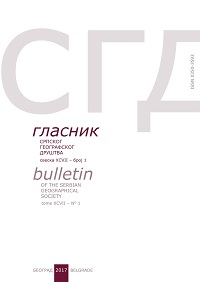Soc stock in different forest-related land-uses in central Stara planina mountain, Bulgaria
Soc stock in different forest-related land-uses in central Stara planina mountain, Bulgaria
Author(s): Tatyana Dimitrova, Maria Sokolovska, Miglena ZhiyanskiSubject(s): Physical Geopgraphy
Published by: Српско географско друштво
Keywords: forest soils; organic carbon stock;
Summary/Abstract: Forest conversions may lead to an accumulation of carbon in vegetation, but little is known about changes in soil C storage with establishment of plantation forests. Understanding these effects is important to addressing issues relevant to ecosystem function and productivity, and to global balance of carbon. The study investigated the effects of the created coniferous plantations on former beech and pasture sites on the soil organic carbon storage. The major forest-related land-uses in the high mountainous regions of central Stara Planina Mountain were investigated: mountainous pasture, coniferous plantations (planted on previous pasture and beech forests between four and five decades ago) and natural beech forests. The experimental data of soil properties, conducted in 2005, 2006 and 2007, were used in determining the variations in organic carbon storage in forest litter and in mineral soil under different land-use patterns. At each site five representative soil profiles were opened and described giving a total 75 soil samples from the soil layers respectively at 0-10, 10-30 and 30-50 cm depth. A total of 55 samples from forest floor layers (Aol, Aof, Aoh and greensward) were collected with 25:25 cm plastic frame. The main soil properties were determined in accordance with the standardized methods in the Laboratory of soil science at the Forest Research Institute - BAS. The IPCC Good Practice Guidance for Land Use, Land Use Change and Forestry was used to estimate the soil organic carbon stock in soil and litter. The results obtained showed that the SOC stock was quite similar among forest land-uses. The conversion of natural beech forests to coniferous plantations in studied region is related with slightly expressed decrease in soil carbon storage. The values of SOC stocks in 0-50 cm soil layer in these sites were 8.5 (±2.1) tones/ha for pine and 11.0 (±1.4) tones/ha for spruce, while under the natural beech forest it was 14.8 (±1.0) tones/ha. The SOC stock in mountainous pasture was 20.7 (± 6.5) tones/ha, while in spruce plantation created on previous pasture it was 13.5 (±2.7) tones/ha. Our finding showed that forest conversions effect in central Stara Planina Mountain is expressed by decrease in SOC stock related with losses of carbon from the upper mineral soil decades after creation of coniferous plantations. Nevertheless the relatively large organic carbon storage in forest litter in the spruce plantations compensated C lost from mineral soil after the land-use change. The overall carbon stock both in forest litter and soil under plantations ranged from 56 tones/ha (pine) to 77 tones/ha (spruce), while under natural beech forest and pasture the values were 70 and 81 tones/ha respectively. But in terms of stability C sequestrated in mineral soil is more desirable than C sequestrated in forest floor which are more vulnerable to decomposition following disturbances. The application of silvicultural activities in coniferous plantations created by conversion of forest lands or grasslands in the region of central Balkan is desirable to improve the carbon sequestration in soils.
Journal: Гласник Српског географског друштва
- Issue Year: 89/2009
- Issue No: 4
- Page Range: 99-107
- Page Count: 9
- Language: English

